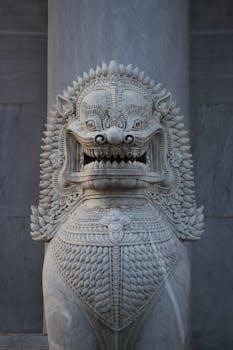Edith Hamilton’s Mythology⁚ An Overview
Edith Hamilton’s “Mythology” is a classic work that has introduced countless readers to the enchanting world of Greek, Roman, and Norse myths․ It has been a popular choice for over seven decades․ Many people search for it in PDF format for easy access and reading․
Availability of “Mythology” in PDF Format
The demand for Edith Hamilton’s “Mythology” in PDF format is substantial, driven by the convenience and accessibility digital files offer․ Many seek downloadable versions of this classic work for various reasons, including academic study, personal enjoyment, and ease of access on multiple devices; While obtaining a free and legal PDF of the complete book can sometimes be challenging due to copyright restrictions, various online platforms and digital libraries may offer excerpts, sample chapters, or even full versions that are legally available․ It is essential to verify the legitimacy of the source before downloading any PDF file to avoid copyright infringement and potential security risks․ Numerous websites and forums are dedicated to sharing resources, and users often discuss where they have found accessible PDF versions․ It’s also worth noting that some educational institutions may provide access to digital copies of the book through their online libraries for their students․ The ease of searching and accessing a PDF version contributes to the continued popularity of this timeless work․
Free PDF Downloads of Edith Hamilton’s “Mythology”
The quest for free PDF downloads of Edith Hamilton’s “Mythology” is a common one among students and mythology enthusiasts alike․ While the book is widely available for purchase, the allure of obtaining a free digital copy is undeniable․ However, it’s important to proceed with caution when seeking such downloads․ Numerous websites may offer seemingly free PDFs, but it is critical to ensure the source is reputable to avoid downloading files that are potentially harmful or violate copyright laws․ Some legitimate avenues might include university or public library websites, which occasionally provide access to digital resources․ It is also common for excerpts or sample chapters to be available for free․ Always be wary of sites that promise full, free versions without any credentials or licensing information․ Many users actively participate in online discussions about locating these PDFs, highlighting both the demand and the difficulties in finding legitimate free options․ The search often involves navigating through various forums and platforms, which underscores the ongoing interest in accessing this work digitally without cost․
Edith Hamilton’s “Mythology” as an eBook
Edith Hamilton’s “Mythology” is not only available in traditional print but also as an eBook, catering to the preferences of modern readers․ The digital format offers significant advantages, such as portability and the ability to adjust font sizes and styles․ This accessibility makes it easier for readers to engage with the text on various devices like tablets, smartphones, and e-readers․ eBook versions are commonly available in formats like EPUB, which ensures compatibility with most e-reading applications․ The search for “Mythology” as an eBook often leads to platforms selling digital books, but it is always advisable to buy from legitimate sources to avoid copyright infringement․ While free PDF versions might be sought after, the security and quality of those sources are never guaranteed, making eBooks a reliable alternative․ Many readers find the convenience of having “Mythology” readily available on their digital devices to be extremely beneficial, whether for academic purposes or personal enjoyment․ Discussions in forums and online groups frequently mention the ease of access provided by these digital formats․

Content and Structure of Hamilton’s “Mythology”
Hamilton’s “Mythology” is structured to explore the rich narratives of Greek, Roman, and Norse myths․ The book delves into the tales of gods, heroes, and monsters, providing a comprehensive look at these ancient stories․
Key Themes in Edith Hamilton’s “Mythology”
“Mythology” by Edith Hamilton explores several key themes that resonate throughout the ancient stories․ One prominent theme is the interplay between fate and free will, often depicting characters grappling with their destinies or attempting to defy them․ The consequences of human actions, both good and bad, are a recurring motif, illustrating the moral complexities of the mythological world․ Divine intervention, or the gods’ involvement in human affairs, is another central theme, showcasing their power and influence․ The concept of heroism, with its various forms and challenges, is also explored, highlighting the qualities and flaws of legendary figures․ Furthermore, the book examines the themes of love, loss, betrayal, and revenge, which drive many of the captivating narratives․ The cyclical nature of life and death is another significant element, often depicted through the stories of rebirth and transformation․ Finally, the timeless relevance of these myths is a key theme, suggesting that these ancient stories reflect universal human experiences․
The Twelve Olympians in Hamilton’s “Mythology”

In Edith Hamilton’s “Mythology,” the Twelve Olympians are central figures, each with distinct personalities and domains․ Zeus, the king of the gods, presides over the heavens, while his brother Poseidon rules the seas․ Hades, the third brother, governs the underworld, though he is not always considered among the Olympians․ Hera, Zeus’s wife, is the queen of the gods, often depicted as jealous and vengeful․ Aphrodite, the goddess of love and beauty, and Ares, the god of war, are also prominent․ Athena, the goddess of wisdom and strategic warfare, is a favorite of many․ Apollo, the god of music, light, and healing, and his twin sister Artemis, the goddess of the hunt and wilderness, also feature prominently․ Hephaestus, the god of fire and craftsmanship, is known for his skill and lameness․ Hermes, the messenger god, is swift and cunning․ Finally, Hestia, the goddess of hearth and home, completes the twelve, although she is sometimes replaced by Dionysus, the god of wine and revelry․ Their stories are richly detailed, highlighting their complex relationships and interactions with mortals․

Usage and Reception
Edith Hamilton’s “Mythology” is widely used in educational settings and literary studies․ Its clear prose and comprehensive coverage make it a valuable resource for both students and enthusiasts․ Its enduring popularity speaks to its timeless appeal․
“Mythology” as an Educational Resource
Edith Hamilton’s “Mythology” has cemented its place as a cornerstone educational resource for students exploring classical literature and ancient civilizations․ Its accessible language and engaging narrative style make it an ideal text for introducing young minds to the complex world of Greek, Roman, and Norse myths․ The book’s structure, which clearly delineates between different pantheons and major myths, assists in comprehension and retention․ Educators frequently assign chapters from “Mythology” to supplement classroom discussions and lectures on mythology․ Its comprehensive nature means it provides a thorough grounding in the key figures and narratives of these ancient traditions․ Furthermore, the book’s popularity has led to the development of various study guides and supplementary materials designed to help students delve deeper into the subject matter․ This makes it a versatile and valuable tool for teaching mythology in a variety of educational settings, from high school literature to college-level courses․ The availability of the book in PDF format allows for easy access and distribution in classrooms, further enhancing its value as a teaching aid․
“Mythology” in Literary Studies
Edith Hamilton’s “Mythology” plays a crucial role in literary studies, serving as a foundational text for understanding the archetypes, themes, and motifs that permeate Western literature․ Its detailed recounting of ancient myths provides essential context for analyzing countless literary works that draw upon these stories for inspiration and symbolism․ From Shakespearean plays to modern novels, the echoes of Greek, Roman, and Norse mythology are pervasive, and Hamilton’s work is instrumental in tracing these influences․ Literary scholars utilize “Mythology” to decode the allegorical and thematic layers within texts, revealing how ancient narratives continue to shape contemporary storytelling․ The book’s accessibility makes it a valuable resource for both undergraduate and graduate students, allowing them to engage with complex literary analyses and interpret texts in relation to their mythological roots․ Furthermore, its widespread use and reputation have established it as a standard reference point for understanding the enduring power of myth in shaping cultural narratives and literary traditions; The availability of the book in PDF format greatly facilitates scholarly research and academic discussions, making it an indispensable tool for anyone delving into literary studies․

Additional Information
Beyond the standard print editions, “Mythology” is available in various formats such as illustrated versions, ebooks, and even audiobooks․ Copyright details and alternative digital file formats, such as epub and doc, are also relevant for readers seeking different access options․
Illustrated Editions of Edith Hamilton’s “Mythology”
Illustrated editions of Edith Hamilton’s “Mythology” enhance the reading experience by bringing the ancient tales to life with visual interpretations․ These editions often feature artwork that complements the text, providing a richer and more immersive journey into the world of gods, heroes, and monsters․ Some editions include classic illustrations, while others may offer more contemporary artistic styles․ The inclusion of images can aid comprehension, particularly for younger readers or those who are visual learners, making the complex narratives more accessible and engaging․ The illustrations serve not just as decoration but as a way to further explore and understand the themes and characters presented within the book․ Such editions provide a different perspective on the ancient world, inviting readers to imagine these mythical figures in a more concrete way․ They are popular among both new readers and long-time fans of Hamilton’s work, offering a fresh way to engage with these timeless stories․ Illustrated versions can also make the book a treasured gift, appealing to collectors and those who appreciate the combination of literature and art․
Copyright Information for Hamilton’s “Mythology”
The copyright status of Edith Hamilton’s “Mythology” is important to consider when seeking PDF versions or other digital formats․ Originally published in 1942, the book’s copyright was renewed in 1969 by Dorian Fielding Reid, indicating that the work is still protected under copyright laws in many regions․ This means that unauthorized distribution or reproduction, such as sharing a PDF without proper permission, is a violation of these laws․ It’s essential to obtain the book from legitimate sources to ensure that you’re not infringing on the author’s rights․ While some older works may enter the public domain after a certain period, the renewal of “Mythology’s” copyright means it remains protected for a considerable time, making it crucial to respect these rights․ Always look for authorized digital versions offered by publishers or reputable online booksellers when accessing the book electronically, which helps to support authors and publishers and ensures you are using a legal copy․
Different Formats of Hamilton’s “Mythology” (epub, doc etc․)
While many users actively search for “Edith Hamilton’s Mythology” in PDF format, it’s worth noting that this work is available in other digital formats as well․ These formats cater to various reading devices and preferences․ For instance, the EPUB format is widely used for ebooks, providing a reflowable text that adapts to different screen sizes, making it ideal for tablets and e-readers․ Additionally, some sources offer the book in DOC or DOCX formats, which are commonly used for word processing and allow for easy editing and note-taking․ Although PDF is popular for its fixed layout, these other formats offer more flexibility․ The availability of “Mythology” in multiple formats ensures that readers can access the work on their preferred device․ It is also possible that some unofficial conversions from PDF to other formats exist, although one should always be sure to use legit sources․
